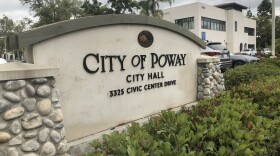Democratic non-incumbent women are more than two-and-a-half times as likely as Republican non-incumbent women to be in House races where their chances are toss-up or better. That's according to an NPR analysis of candidate data from Daily Kos and race ratings from Cook Political Report.
A record number of women ran for and were nominated for office this year — that's true among House, Senate, state legislature and governor candidates — and the overwhelming majority of them have been Democrats.
But these data show that even among those women still in the running, those Democratic women on the whole also have a much better chance of being elected as Election Day approaches.
Only around 1 in 10 Republican women who are non-incumbent nominees in House races are in contests that the Cook Political Report rates as a "toss-up" or better, while the same is true for nearly 3 in 10 Democratic women. Republican and Democratic men fall in the middle. (Throughout this article, numbers will not include Louisiana, which has primaries on Election Day and therefore has not yet nominated House candidates.)
It's not surprising for non-incumbents on the whole to have tough chances of getting elected, especially when facing off against sitting Congress members, who often have name recognition and fundraising advantages.
Of the 127 Democratic non-incumbent women candidates remaining in House races, about 1 in 10 are in "likely" or "solid" Democratic districts. The share is similar for Democratic men.
On the Republican side, men do a little better — more than 1 in 7 are in "solid" or "likely" Republican districts.
None of those are huge numbers, but they are also — literally — infinitely better than the playing field for GOP women. Zero Republican non-incumbent women are in such races.
Why the gender and partisan gaps?
In part, the gap between Democratic and Republican women in their chances of winning may be the result of a year in which Democrats are looking particularly strong. In a recent NPR poll, Democrats led Republicans by 9 points among likely voters on the question of whom people wanted to elect to the House in their districts.
But, on top of that, it is possible that voters are particularly excited about Democratic women this year. In open primaries this year, Democratic women candidates enjoyed a 10-point advantage over men, as an August analysis from FiveThirtyEight found.
It's also possible that the particular women in these Democratic races were well-suited to running in this particular election year. As NPR reported earlier this year, Democratic women veterans may be uniquely effective foils to President Trump, who received multiple military service deferments and works to craft a heavily masculine persona.
Some political scientists have also theorized that there is a "Jill Robinson" effect among women politicians. The effect is named after legendary African-American baseball player Jackie Robinson, and refers to the possibility that women candidates, expecting gender discrimination or underestimating their own abilities, will only run for office if they are supremely qualified. (However, that wouldn't explain why one party's women candidates are faring better than the other party's.)
A dearth of GOP women
Just looking at percentages, as we've done here, obscures one very important point in these data: When it comes to raw numbers, men far outnumber women, especially on the Republican side.
Here's how the race ratings look in terms of numbers of candidates, rather than shares of candidates.
This year, nearly half of non-incumbent Democratic candidates are women. Meanwhile, women account for roughly 1 in 5 non-incumbent Republican candidates.
And this holds true well beyond just this year's crop of candidates. Women account for less than 1 in 5 members of the House and less than 1 in 4 members of the Senate right now, according to data from Rutgers University's Center for American Women and Politics. In both houses, Democratic women outnumber Republicans by approaching 3 to 1.
There are many reasons for this. For one, women simply are less likely to be Republican than Democratic (a phenomenon whose causes are far too complicated to get into here).
On top of that, Republican women lack a massive, well-established, women-focused juggernaut like EMILY's List — a group that supports Democratic women who support abortion rights — to train candidates and raise money. There is the anti-abortion rights Susan B. Anthony List, but it also supports many men candidates. And the conservative group Maggie's List doesn't raise nearly as much money as EMILY's list.
In addition, Republican voters are far less likely than Democratic voters to believe there should be more women in office — which could also contribute to Republican women not having been nominated in many competitive races.
Copyright 2018 NPR. To see more, visit http://www.npr.org/.






